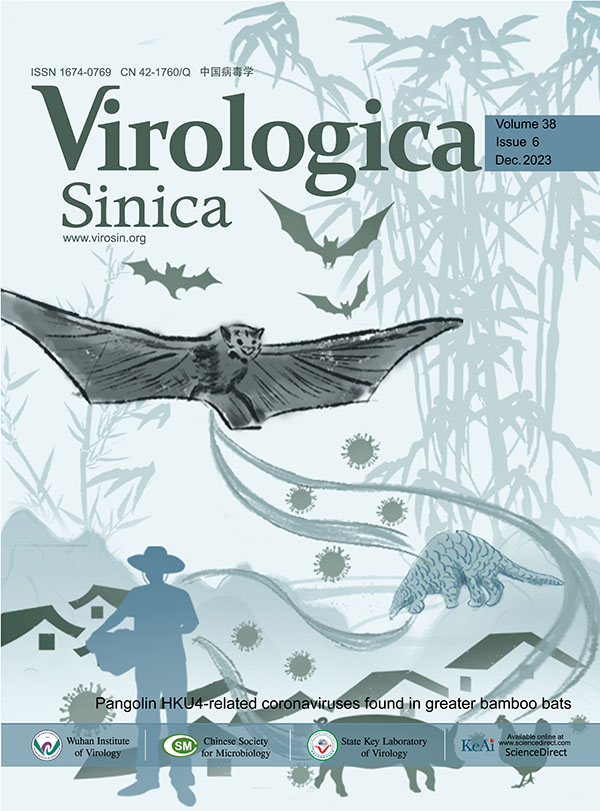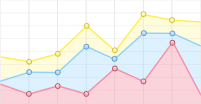-
Alexandra, V., Lyras, G., Vos, J.D., Dermitzakis, M., 2010. Rabbits, Hares and Pikas.
-
Attoui, H., Biagini, P., Stirling, J., Mertens, P.P., Cantaloube, J.F., Meyer, A., de Micco, P., de Lamballerie, X., 2001. Sequence characterization of Ndelle virus genome segments 1, 5, 7, 8, and 10: evidence for reassignment to the genus Orthoreovirus, family Reoviridae. Biochem. Biophys. Res. Commun. 287, 583–588.
-
Bankevich, A., Nurk, S., Antipov, D., Gurevich, A.A., Dvorkin, M., Kulikov, A.S., Lesin, V.M., Nikolenko, S.I., Pham, S., Prjibelski, A.D., Pyshkin, A.V., Sirotkin, A.V., Vyahhi, N., Tesler, G., Alekseyev, M.A., Pevzner, P.A., 2012. SPAdes: a new genome assembly algorithm and its applications to single-cell sequencing. J. Comput. Biol. 19, 455–477.
-
Chua, K.B., Crameri, G., Hyatt, A., Yu, M., Tompang, M.R., Rosli, J., McEachern, J., Crameri, S., Kumarasamy, V., Eaton, B.T., Wang, L.F., 2007. A previously unknown reovirus of bat origin is associated with an acute respiratory disease in humans. Proc.Natl. Acad. Sci. U. S. A. 104, 11424–11429.
-
Crameri, G., Todd, S., Grimley, S., McEachern, J.A., Marsh, G.A., Smith, C., Tachedjian, M., De Jong, C., Virtue, E.R., Yu, M., Bulach, D., Liu, J.P., Michalski, W.P., Middleton, D., Field, H.E., Wang, L.F., 2009. Establishment, immortalisation and characterisation of pteropid bat cell lines. PLoS One 4, e8266.
-
Duncan, R., 1999. Extensive sequence divergence and phylogenetic relationships between the fusogenic and nonfusogenic orthoreoviruses: a species proposal. Virology 260, 316–328.
-
Gauvin, L., Bennett, S., Liu, H., Hakimi, M., Schlossmacher, M., Majithia, J., Brown, E.G., 2013. Respiratory infection of mice with mammalian reoviruses causes systemic infection with age and strain dependent pneumonia and encephalitis. Virol. J. 10, 67.
-
Huang, C., Liu, W.J., Xu, W., Jin, T., Zhao, Y., Song, J., Shi, Y., Ji, W., Jia, H., Zhou, Y., Wen, H., Zhao, H., Liu, H., Li, H., Wang, Q., Wu, Y., Wang, L., Liu, D., Liu, G., Yu, H., Holmes, E.C., Lu, L., Gao, G.F., 2016. A bat-derived putative cross-family recombinant coronavirus with a reovirus gene. PLoS Pathog. 12, e1005883.
-
King, A.M.Q., Adams, M.J., Carstens, E.B., Lefkowitz, E.J., 2011. Virus Taxonomy: Ninth Report of the International Committee on Taxonomy of Viruses. Elsevier Academic Press.
-
Knipe, D.M., Howley, P.M., 2013. Fields Virology. LWW.
-
Kohl, C., Lesnik, R., Brinkmann, A., Ebinger, A., Radonic, A., Nitsche, A., Muhldorfer, K., Wibbelt, G., Kurth, A., 2012. Isolation and characterization of three mammalian orthoreoviruses from European bats. PLoS One 7, e43106.
-
Kumar, S., Stecher, G., Tamura, K., 2016. MEGA7: molecular evolutionary genetics analysis version 7.0 for bigger datasets. Mol. Biol. Evol. 33, 1870–1874.
-
Lelli, D., Moreno, A., Lavazza, A., Bresaola, M., Canelli, E., Boniotti, M.B., Cordioli, P., 2013. Identification of Mammalian orthoreovirus type 3 in Italian bats. Zoonoses Public Health 60, 84–92.
-
Lelli, D., Moreno, A., Steyer, A., Naglič, T., Chiapponi, C., Prosperi, A., Faccin, F., Sozzi, E., Lavazza, A., 2015. Detection and characterization of a novel reassortant mammalian orthoreovirus in bats in Europe. Viruses 7, 5844–5854.
-
Li, W., Shi, Z., Yu, M., Ren, W., Smith, C., Epstein, J.H., Wang, H., Crameri, G., Hu, Z., Zhang, H., Zhang, J., McEachern, J., Field, H., Daszak, P., Eaton, B.T., Zhang, S., Wang, L.F., 2005. Bats are natural reservoirs of SARS-like coronaviruses. Science 310, 676–679.
-
Li, Y., Xiao, H., Huang, C., Sun, H., Li, L., Su, J., Ma, J., Liu, D., Wang, H., Liu, W., Gao, G.F., Li, X., Yan, J., 2015a. Distribution of sialic acid receptors and experimental infections with different subtypes of influenza A viruses in Qinghai-Tibet plateau wild pika. Virol. J. 12, 63.
-
Li, Z., Shao, Y., Liu, C., Liu, D., Guo, D., Qiu, Z., Tian, J., Zhang, X., Liu, S., Qu, L., 2015b.Isolation and pathogenicity of the mammalian orthoreovirus MPC/04 from masked civet cats. Infect. Genet. Evol. 36, 55–61.
-
Li, Z., Liu, D., Ran, X., Liu, C., Guo, D., Hu, X., Tian, J., Zhang, X., Shao, Y., Liu, S., Qu, L., 2016. Characterization and pathogenicity of a novel mammalian orthoreovirus from wild short-nosed fruit bats. Infect. Genet. Evol. 43, 347–353.
-
Li, X., Wang, L., Liu, P., Li, H., Huo, S., Zong, K., Zhu, S., Guo, Y., Zhang, L., Hu, B., Lan, Y., Chmura, A., Wu, G., Daszak, P., Liu, W.J., Gao, G.F., 2021. A novel potentially recombinant rodent coronavirus with a polybasic cleavage site in the spike protein.J. Virol. 95, e0117321.
-
Lodder, W.J., de Roda Husman, A.M., 2005. Presence of noroviruses and other enteric viruses in sewage and surface waters in the Netherlands. Appl. Environ. Microbiol. 71, 1453–1461.
-
Lodder, W.J., van den Berg, H.H., Rutjes, S.A., de Roda Husman, A.M., 2010. Presence of enteric viruses in source waters for drinking water production in the Netherlands.Appl. Environ. Microbiol. 76, 5965–5971.
-
Luo, X.L., Lu, S., Qin, C., Shi, M., Lu, X.B., Wang, L., Ga, S., Jin, D., Ma, X.L., Yang, J., Dai, Y., Bao, L.L., Cheng, Y.P., Ge, Y.J., Bai, Y.B., Zhu, W.T., Pu, J., Sun, H., Huang, Y.Y., Xu, M.C., Lei, W.J., Dong, K., Yang, C.X., Jiao, Y.F., Lv, Q., Li, F.D., Xu, J., 2023. Emergence of an ancient and pathogenic mammarenavirus. Emerg.Microbes Infect. 12, e2192816.
-
Morecki, R., Glaser, J.H., Cho, S., Balistreri, W.F., Horwitz, M.S., 1984. Biliary atresia and reovirus type 3 infection. N. Engl. J. Med. 310, 1610.
-
Muhire, B.M., Varsani, A., Martin, D.P., 2014. SDT: a virus classification tool based on pairwise sequence alignment and identity calculation. PLoS One 9, e108277.
-
Ouattara, L.A., Barin, F., Barthez, M.A., Bonnaud, B., Roingeard, P., Goudeau, A., Castelnau, P., Vernet, G., Paranhos-Baccala, G., Komurian-Pradel, F., 2011. Novel human reovirus isolated from children with acute necrotizing encephalopathy.Emerg. Infect. Dis. 17, 1436–1444.
-
Shi, Z., 2010. Bat and virus. Protein Cell 1, 109–114.
-
Smith, I., Wang, L.F., 2013. Bats and their virome: an important source of emerging viruses capable of infecting humans. Curr. Opin. Virol. 3, 84–91.
-
Smith, A.T., Badingqiuying, Wilson, M.C., Hogan, B.W., 2019. Functional-trait ecology of the plateau pika Ochotona curzoniae in the Qinghai-Tibetan Plateau ecosystem.Integr. Zool. 14, 87–103.
-
Spinner, M.L., Di Giovanni, G.D., 2001. Detection and identification of mammalian reoviruses in surface water by combined cell culture and reverse transcription-PCR.Appl. Environ. Microbiol. 67, 3016–3020.
-
Steyer, A., Gutierrez-Aguire, I., Kolenc, M., Koren, S., Kutnjak, D., Pokorn, M., PoljsakPrijatelj, M., Racki, N., Ravnikar, M., Sagadin, M., Fratnik Steyer, A., Toplak, N., 2013. High similarity of novel orthoreovirus detected in a child hospitalized with acute gastroenteritis to mammalian orthoreoviruses found in bats in Europe. J. Clin.Microbiol. 51, 3818–3825.
-
Su, S., Xing, G., Wang, J., Li, Z., Gu, J., Yan, L., Lei, J., Ji, S., Hu, B., Gray, G.C., Yan, Y., Zhou, J., 2016. Characterization of H7N2 avian influenza virus in wild birds and pikas in Qinghai-Tibet Plateau area. Sci. Rep. 6, 30974.
-
Thimmasandra Narayanappa, A., Sooryanarain, H., Deventhiran, J., Cao, D., Ammayappan Venkatachalam, B., Kambiranda, D., LeRoith, T., Heffron, C.L., Lindstrom, N., Hall, K., Jobst, P., Sexton, C., Meng, X.J., Elankumaran, S., 2015.A novel pathogenic Mammalian orthoreovirus from diarrheic pigs and Swine blood meal in the United States. mBio 6 e00593-15.
-
Tyler, K.L., Barton, E.S., Ibach, M.L., Robinson, C., Campbell, J.A., O'Donnell, S.M., ValyiNagy, T., Clarke, P., Wetzel, J.D., Dermody, T.S., 2004. Isolation and molecular characterization of a novel type 3 reovirus from a child with meningitis. J. Infect. Dis. 189, 1664–1675.
-
Wang, L., Fu, S., Cao, L., Lei, W., Cao, Y., Song, J., Tang, Q., Zhang, H., Feng, Y., Yang, W., Liang, G., 2015. Isolation and identification of a natural reassortant mammalian orthoreovirus from least horseshoe bat in China. PLoS One 10, e0118598.
-
Woolhouse, M.E., Gowtage-Sequeria, S., 2005. Host range and emerging and reemerging pathogens. Emerg. Infect. Dis. 11, 1842–1847.
-
Xu, Z., Feng, Y., Chen, X., Shi, M., Fu, S., Yang, W., Liu, W.J., Gao, G.F., Liang, G., 2022.Virome of bat-infesting arthropods: highly divergent viruses in different vectors.J. Virol. 96, e0146421.
-
Yan, Y., Gu, J.Y., Yuan, Z.C., Chen, X.Y., Li, Z.K., Lei, J., Hu, B.L., Yan, L.P., Xing, G., Liao, M., Zhou, J.Y., 2017. Genetic characterization of H9N2 avian influenza virus in plateau pikas in the Qinghai Lake region of China. Arch. Virol. 162, 1025–1029.
-
Yu, Z., Cheng, K., Sun, W., Xin, Y., Cai, J., Ma, R., Zhao, Q., Li, L., Huang, J., Sang, X., Li, X., Zhang, K., Wang, T., Qin, C., Qian, J., Gao, Y., Xia, X., 2014. Lowly pathogenic avian influenza (H9N2) infection in Plateau pika (Ochotona curzoniae), Qinghai Lake, China. Vet. Microbiol. 173, 132–135.
-
Zhou, J., Sun, W., Wang, J., Guo, J., Yin, W., Wu, N., Li, L., Yan, Y., Liao, M., Huang, Y., Luo, K., Jiang, X., Chen, H., 2009. Characterization of the H5N1 highly pathogenic avian influenza virus derived from wild pikas in China. J. Virol. 83, 8957–8964.
-
Zhou, P., Yang, X.L., Wang, X.G., Hu, B., Zhang, L., Zhang, W., Si, H.R., Zhu, Y., Li, B., Huang, C.L., Chen, H.D., Chen, J., Luo, Y., Guo, H., Jiang, R.D., Liu, M.Q., Chen, Y., Shen, X.R., Wang, X., Zheng, X.S., Zhao, K., Chen, Q.J., Deng, F., Liu, L.L., Yan, B., Zhan, F.X., Wang, Y.Y., Xiao, G.F., Shi, Z.L., 2020. A pneumonia outbreak associated with a new coronavirus of probable bat origin. Nature 579, 270–273.
-
Zhu, N., Zhang, D., Wang, W., Li, X., Yang, B., Song, J., Zhao, X., Huang, B., Shi, W., Lu, R., Niu, P., Zhan, F., Ma, X., Wang, D., Xu, W., Wu, G., Gao, G.F., Tan, W., China Novel Coronavirus, I., Research, T., 2020. A novel coronavirus from patients with pneumonia in China, 2019. N. Engl. J. Med. 382, 727–733.
















 DownLoad:
DownLoad: